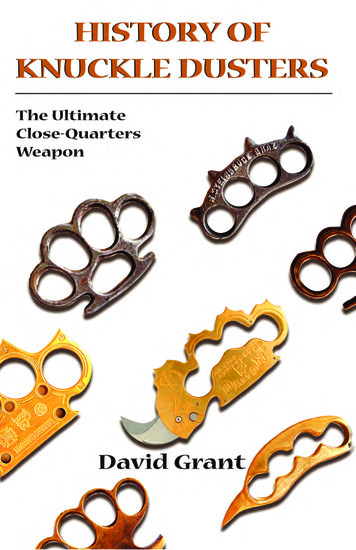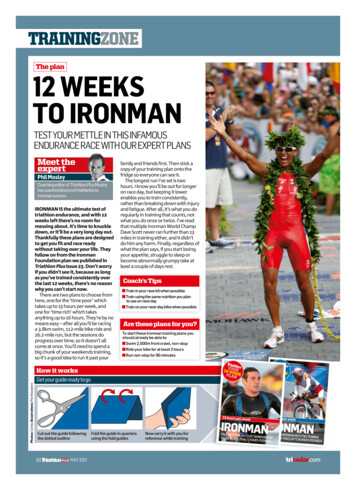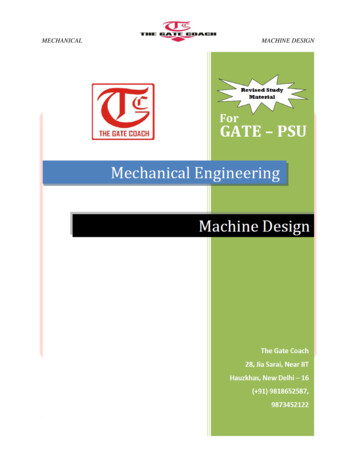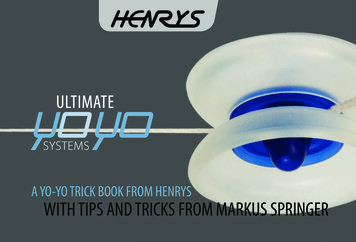
Transcription
HISTORY OFKNUCKLE DUSTERS
This page intentionally left blank.
HISTORY OFKNUCKLE DUSTERSThe Ultimate Close-Quarters WeaponDavid GrantPaladin Press Boulder, Colorado
Also by David Grant:Knuckle Dusters and Knuckle KnivesTomahawks: Traditional to TacticalHistory of Knuckle Dusters: The Ultimate Close-Quarters Weaponby Dave GrantCopyright 2007 by Dave GrantISBN 13: 978-1-58160-630-0Printed in the United States of AmericaPublished by Paladin Press, a division ofPaladin Enterprises, Inc.,P.O. Box 1307Boulder, Colorado 80306 USA 1.303.443.7250Direct inquiries and/or orders to the above address.PALADIN, PALADIN PRESS, and the “horse head” design are trademarksbelonging to Paladin Enterprises and registered in United States Patent andTrademark Office.All rights reserved. Except for use in a review, no portion of this book may bereproduced, stored in or introduced into a retrieval system, or transmitted inany form without the express written permission of the publisher. Thescanning, uploading and distribution of this book by the Internet or any othermeans without the permission of the publisher is illegal and punishable by law.Please respect the author’s rights and do not participate in the any form ofelectronic piracy of copyrighted material.Neither the author nor the publisher assumes any responsibility for the use ormisuse of information contained in this book.Visit our website at www.paladin-press.com.
ContentsIntroduction.1Chapter 1: Early Knuckle Dusters.5Classic T-Handle American Knuckle DustersClassic American Knuckle DusterDarley Aluminum KnucklesClassic British Knuckle DusterMailed Fist Knuckle DustersChapter 2: The Knuckle Duster Goes to War.19World War I Austrian Military Issue Knuckle DustersBritish Military-Issue Knuckle DustersModern Brass BC 41 Knuckle DustersSheffield-Style Knuckle DustersStone Knuckle DustersChapter 3: Modern Designs: Mass Production, Customs, andCombat Knuckles .29“Dave Courtney Special” Knuckle DustersPaper Weight Knuckle DustersChinese Mass-Produced Knuckle DustersChapter 4: Modern Customs.37Custom Maltese Cross Knuckle DustersCustom Two-Finger StylesChapter 5: Modern Combat Knuckle Dusters .41Dalton Combat Cutlery Warfist: Plain, Hardride,and Warhorse ChoppersV
History of Knuckle DustersCopy of Dalton Combat Cutlery WarfistCopy Inspired by Devil’s PlaygroundCopy of Austrian World War I Military-Issue Knuckle DusterRat TailBaby Rat Tail I and IIHammer FistBack Street Products Custom Knuckle DusterChapter 6: Knuckle Duster Combination Weapons.57Theater-Made Knuckle KnivesCustom-Made Appleby Knuckle KnifeOSS “Hatpin” Knuckle KnifeDalton Combat Cutlery InterrogatorDalton Combat Cutlery Devil’s PlaygroundLe Centenaire Knuckle Duster PistolDolne “Apache” Knife/Pistol/Knuckle DusterDelhaxhe Knuckle/Knife/GunK.O. Glove Leather Knuckle DusterChapter 7: Various Knuckle Duster Related Patents.77Survival Tool 1Survival Tool 2Spring-Mounted Knuckle KnifeRound-Finger Stall Knuckle DusterOyster ShuckerMachete DaggerNovak Knuckle Duster PistolHollinshead Ram KnifeHarstad DaggerHarrison Knuckle KnifeBaton with Knuckle StrapWeb Sites.89VI
AcknowledgmentsThis book would not have been possible without the help andencouragement of friends and family alike. The collectors andmanufacturers that kindly provided pictures and information tosupplement what I already had made this volume better. DannyWhite from the Brass Knuckle Collector Club (see Web site at theback of the book), Steve Michaluk for his Mailed Fist informationand pictures, and the expertise and great photography for theDalton items provided by Mark Kukelkorn helped tremendously.Many individuals wished to remain anonymous. My gratitudeextends to them as well. You know who you are, and your efforts toincrease the knowledge of knuckle dusters and decrease their stigmais appreciated by me and other interested readers. My familydeserves and gets the greatest praise for their support of and patiencewith this project. My eldest son, Connor, especially liked trying oneach set of knuckle dusters that lay on the desk while I wrote.VII
This page intentionally left blank.
IntroductionWhen I first started researching knuckle dusters, there was aclear absence of data to draw from; knowledgeable collectorstended to be secretive and hard to find, and nothing really substantive had been written. But the subject was so intriguing, and I wasso entirely captivated by these pocket-sized weapons, that Iplugged along collecting examples, pictures, and as much information as I could. The end result was my book Knuckle Dusters andKnuckle Knives (Iron Wave Publishing, 2005), a collection ofknuckles and knives showing the diversity and some of the historyof this significant subject.As happens with so many historical research projects, I wasuncertain that I had covered the subject as clearly and completelyas possible, but it was the best I could do at the time, and soKnuckle Dusters and Knuckle Knives was released. The book wasa hit right away, being the first and only book to even touch onthe subject. Soon after its release, my uncertainty about the completeness of the subject became justified. I discovered someamazing examples of knuckles I never knew existed, both historically significant ones and incredible new designs that needed tobe exposed.The most fantastic by-product of the book was the sudden contact by dozens of collectors who discovered my Web site,www.knuckledusterbook.com, and started sending me e-mails with1
History of Knuckle Dustersquestions, comments, historical data and, best of all, pictures oftheir collections. Soon I was blissfully swimming in a collector’sdream of information, which I have now compiled and presentedin this book.History of Knuckle Dusters will hopefully excite existingknuckle duster collectors and, more importantly, get others startedon this wonderful adventure. New and old collectors should bethrilled with the new designs that are coming out; cheap but interesting knuckles from China continue to enter the market alongsidehigh-end combat knuckle dusters by makers such as DaltonCombat Cutlery (DCC) and Back Street Products (BSP). I believethis is just the tip of the iceberg. Much like their also maligned andoutlawed cousin, the switchblade, knuckle dusters are seeing aresurgence in popularity as a self-defense weapon that, unlike agun or knife, is less likely to kill but is very effective in closequarter combat.So what is the future of the knuckle duster? Hopefully, thosecountries and states that have outlawed knuckles will see the errorof their ways and back off their draconian laws regarding theseitems. It has happened with switchblades in the United States, andthe result has been beautiful custom automatic knives that are welldesigned and strong being sold to citizens for carry and collection.Regardless of their legal standing, more and more people are buying knuckles, for whatever reason, and they rarely stop at just oneset. One on-line seller recently reported that over the 2005Christmas season his shop sold more than 400 knuckle dusters!Another aspect of knuckle dusters is the way craftsmen havecombined them with other weapons to create useful hybrids.Knives, guns, and batons have all been incorporated into more useful tools when knuckles are added. This trend has again been seenas makers look for “new” ways to differentiate themselves andmake their designs attractive.With every small step, knuckle dusters will become moreacceptable; at the beginning of the 20th century, they were sold in2
Introductionpolice supply and hardware catalogs! The vilification of the knuckle duster really occurred much as it did with the switchblade: blaming an object for the actions of individuals who used them inappropriately. Hopefully, this trend of vilification will change, but as gunowners have seen, it is not an easy obstacle to overcome.So join with me if you are new to the fascinating subject ofknuckle dusters, or are a veteran collector, and take a look at theseweapons that have been around for at least 200 years and will continue to be carried, collected, and used forever.3
This page intentionally left blank.
Chapter1EARLY KNUCKLE DUSTERSDating back to before the American Civil War, mass-producedknuckle dusters were neither rare nor considered particularly evil.Often sold in hardware and sporting goods stores and catalogs, the19th- and early 20th-century weapons could be had as cheaply as agood pocket knife. Despite the low cost of the knuckle dusters, someindividuals sought to make their own, whether for the challenge orthe lack of availability where they lived. Many examples of handmade knuckle dusters cast from lead, drilled from brass bar stock, orhammered out of iron by a blacksmith have been dug up on CivilWar sites.The mass-produced knuckles of this period had three distinctive styles: the American T-handle, the American classic, and theBritish classic. Within these styles there are some distinctions,mainly in size and materials, but for decades these three styleswere what was available. Even such companies as WinchesterArms entered the knuckle duster market with a unique item calledthe “Brute Tamer,” to be used and carried by women. Most knuckle makers left off any markings on their offerings, and except inrare cases, we do not know who they were.Early in the 20th century, police supply catalogs began toadvertise knuckles and other similar weapons, such as the leather,shot-filled strap that covered the hand. It was perfectly acceptablefor a law enforcement officer to carry a weapon like this in order5
History of Knuckle Dustersto stop a fight without shooting or clubbing a suspect.Not much thought was given to knuckle dusters until theybegan to be used by gangsters, thugs, and union busters. Used tomenace, intimidate, and often to beat those who opposed them,knuckles became a symbol of these criminals and have sadlyremained so up to the present day in a lot of jurisdictions.6
Early Knuckle DustersCLASSIC T-HANDLE AMERICAN KNUCKLE DUSTERSMakers: UnknownPopular in the last part of the 19th century and into the early20th century, the T-handled knuckle duster is distinctive not justfor its palm swell but also for the straight-across finger stalls. It isinteresting to note that many of these knuckle dusters can only beworn one way, as the finger stalls get smaller from one side to theother. The stalls are also usually not perfectly round, but ratheroblong in shape. The straight-across design is not as comfortableas other knuckle dusters that curve and do not spread the fingersas much.While the T-handle is mostly referred to as an Americandesign, examples sold by British firms have been noted, and theycertainly influenced the typical British design that refined theshape so as to be more comfortable. Made from steel, iron, aluminum, or brass, the T-handle examples are not uncommon, and doappear from time to time for sale.7
History of Knuckle DustersCLASSIC AMERICAN KNUCKLE DUSTERSMakers: UnknownThe most well-known American designs surfaced in the firsthalf of the 20th century. Drawing on earlier designs, these moremodern examples have developed into the most common knuckleswe see today. Thefamiliar shape contains four roughlyround finger stallswith either roundedor square protrusions along the topedge of the knuckles. The curvedcalm swell isattached to theknuckle stalls section by two “posts,”and a stylish emptyspace is created.Made from steel,iron, brass, aluminum, and evencopper, this style ofknuckle duster hashad minor changesover the last century, but the basicdesign hasremained intact.Most notably, it isthe size of thePhoto from private collection.8
Early Knuckle DustersPhoto from private collection.9
History of Knuckle Dustersknuckle stalls that has undergone the most changes. Early knuckleswere quite tight and overall quite small, but were comfortablewhen on the hand. As the years went on, the size of the stallincreased, which meant easier access but also spread out the fingers, which can become an issue when striking.The knuckle dusters shown here are early examples that wereoften sold through catalogs—hardware, police supply, and sportinggoods. Examples with the heavy protrusions on the outer edgeswere sold in a hardware mail order catalog. Since the 1970s, thisstyle was sold as “paperweights” and “belt buckles” in firearmsand security magazines. Today, many of the imported knuckleofferings use this venerable style in their makeup, adding someextras for looks but never straying from the original.10
Early Knuckle DustersDARLEY ALUMINUM KNUCKLES(MADE FOR DARLEY POLICE SUPPLY)A variation of the classic American knuckle duster, these wereavailable from Darley Police Supply. Made from aluminum, theywere feather light. However, they were very thin, approximately5mm, or less than a quarter inch. While this made them easy tocarry and conceal, they were not nearly as effective as larger, heavier knuckles and could cut into the hand upon impact, causingsome bruising.Photo from private collection.11
History of Knuckle DustersThe W.S. Darley & Co. Police Supply catalog advertisementdescribes the knuckles like this:Aluminum KnucklesLight but strong. A handful of self-defense for thepoliceman in a tight pinch. Settles such emergencies better than arguments, without fuss or noise.Fits hand comfortably, carries nicely in pocket.Photo from privatecollection.12
Early Knuckle DustersCLASSIC BRITISH KNUCKLE DUSTERSMakers: VariousIt is unlikely that the classic British knuckle duster designdeveloped on its own, distinct from its American counterparts. Itdoes seem to take a variety of individual traits from the T-handleand classic American knuckles and blend them into a highly functional, very comfortable design. The four knuckle stalls are shapedto fit the hand in one direction only; the smallest finger has a stallthat will fit only itcomfortably and notthe index finger if it isput on the wrong way.Some of the AmericanT-handle designs dothe same thing.The stalls are moreergonomically set outin a curve rather thanstraight across, echoing the American classic design. The oneaspect that really setsthem apart, and isindeed a better design,is the way the stalls aremore oblong thanround and taper fromlarge at the top tosmall at the bottom.This allows for entryinto the stalls of theindividual fingerPhoto from private collection.13
History of Knuckle Dustersknuckles. When the knuckles clear the sides, the fingers settle intoa narrower, comfortable base. The fingers are not spread apart asmuch as with large round stalls, and the knuckle duster is easy toget on and off.The British design was produced for decades and sold bysporting goods companies alongside shotguns, rifles, and other“outdoor” items. Most examples are very well made, cast frombrass and aluminum andeven preciousmetals as well.They do varyin size, withsome of thesmaller examples being difficult to put onif the wearer’shands are ofmedium size orlarger. It mustbe rememberedthat in the earlypart of the 20thcentury, menwere on average somewhatsmaller thantoday, and theBritish knuckleduster was created to fitsnuggly.Photo from private collection.14
Early Knuckle DustersMAILED FIST KNUCKLE DUSTERSMaker: Mailed Fist Manufacturing Co., Utica, New YorkCreated by W.A. Hicks in the early part of the 20th century,the Mailed Fist was the first (and possibly last) attempt to create abusiness venture solely around a single production knuckle dusterdesign. Aimed at the law enforcement market, the Fist was presented as a less-than-lethal alternative to firearms and billy clubs. Theliterature accompanying each set of Fists states that Mr. Hicks hadenjoyed a long career in law enforcement and had designed theseknuckle dusters for his own use. Likely made from aluminum, theFist appears to be cut from bar stock rather than cast. It isdescribed as “light in weight” and so could not be made from brassor steel. Sold in pairs, each Fist had a unique serial number andwas registered to the owner. An attempt was made to patent the15
History of Knuckle Dustersdesign, but searches show this was unsuccessful. Not much isknown about how long the Mailed Fist Manufacturing Co. was inbusiness or how many Fists were sold.Consisting of four round finger stalls above a uniquely configured palm swell, the Mailed Fist is unlike any other knuckle dustermade. The finger stalls are well laid out in a gentle curve, but theyare spaced too far apart and are too small to fit even a mediumsized hand. Even the pictures supplied with the Fist show a wearerwith it only on the second knuckle bones of the hand. The replicathat was created for this chapter was difficult to get on over theknuckle joint, making it impractical forquick deployment.The palm swell isalso strange in that itis very uncomfortable. While mostknuckle dustersemploy a convex outward curve, theMailed Fist utilizes aconcave inwardcurve, which is hardto hold.Despite its deficiencies, the MailedFist is a collector’sdream, especiallycoming with theoriginal box andpapers. It once againshows how theknuckle duster wasseen as a viable toolReplica photo from private collection.16
Early Knuckle Dustersfor law enforcement prior to being vilified by the media.Documents provided by Steve Michaluk.17
2ChapterTHE KNUCKLE DUSTERGOES TO WARIn the early part of the 20th century, countries conducted warfare differently than they do today. The advent of the machine gun,better artillery, and the use of aircraft made the old ways of combatseem obsolete. This became obvious during World War I as theopposing sides lined up and spread out in trenches across Europe.Mass charges were bloody and ineffective, and a stalemate settled inon the battlefield. Frontline soldiers, however, required handweapons to augment the slow bolt-action rifles that were difficult toutilize as a striking weapon in the close quarters of an enemy trench.Soldiers used a variety of knives, bayonets, trench clubs, andentrenching tools to fight hand-to-hand with their enemies.The U.S. and British troops were issued or privately purchased knives with knuckle duster handles, such as the AmericanMark I and the Robbins of Dudley knives (see Knuckle Dustersand Knuckle Knives, available from Paladin Press). Some examples of knuckle dusters with British Broad Arrow property markshave been seen, and knuckles purchased privately may have madeit into the trenches as well. The Austrians provided an iron knuckle duster to some troops, but overall it was a rare and largelyundocumented armament.After World War I, the knuckle duster saw some service with theOffice of Strategic Services (OSS) and was carried by agents behindthe lines, but it largely drops out of sight in military situations.19
History of Knuckle DustersWORLD WAR I AUSTRIANMILITARY-ISSUE KNUCKLE DUSTERSMaker: H. Steinbruck, Graz, AustriaProduced during World War I, both of these sets of knuckledusters are rare examples of the weapons given to frontlineAustrian troops to fight with in the trenches. Because they wereconstructed on a curve with no palm swell, it is entirely possiblethey were meant to be held along with another weapon, likely abayonet or trench knife. The four round finger stalls are not largeenough to fit gloved hands but have plenty roomy for bare fingersto slide into.The one sethas six spikesalong the topedge: four ontop and twoon either sidefor inflictingdamage during a hammerblow. Theother set hasonly fourspikes on thetop edge.Both are castfrom iron andprone to rust.Both setsof knuckledusters arecompact andPhoto from private collection.20
The Knuckle Duster Goes to Warmassive at the same time. The way they are designed means thereis little extra metal surrounding the finger stalls; having no palmswell really reduces the footprint. Despite this, the knuckles areweighty due to the thickness; they are 0.625 inch thick, and veryheavy, being made from iron. The curved design fits the hand nicely, and striking a solid mass with it does not hurt the hand. Indeed,it imparts a certain confidence in the user, something that washighly desirable in the trenches where close-quarter, hand-to-handcombat was quite normal.Photo from private collection.21
History of Knuckle DustersBRITISH MILITARY-ISSUE KNUCKLE DUSTERSMakers: VariousWhile the knuckle dusters in this section are arguably of thesame design as the classic British design presented earlier, theirnoteworthy feature is their acceptance by the military as a specialissue weapon. The mark on both examples that makes this clear isthe British “broad arrow” stamp, the official government propertymark found on most military-issue gear of the 20th century. Theset marked “A.K. & Co. 1915” has the broad arrow clearlystamped above the maker’s mark. The age is clear from the patinafinish on the brass, and the date stamp puts it in the middle ofWorld War I. The second example is more likely a presentationpiece created in limited or even one-off quantities. Cast from silverPhoto of silver/gold knuckle duster from private collection.22
The Knuckle Duster Goes to Warand plated in gold, this knuckle duster is smaller in size and alsostamped with a broad arrow mark. Age is undetermined, but it waslikely created before World War II.Whether knuckle dusters were issued to and carried by anynumber of British soldiers is unknown. They were readily availablethrough sporting catalogs and were purchased privately along witha great variety of knuckle knives, particularly the Robbins ofDudley and Clements knives. It is also likely that British SpecialOperations Executive (SOE ) agents carried knuckle dusters likethese on operations. Their portability, concealability, and utilitywere perfect for a backup weapon, along with a garrote, knife, andsuppressed pistol.Photo of A.K. & Co. knuckle duster courtesy of Simon Arnold.23
History of Knuckle DustersMODERN BRASS BC 41 KNUCKLE DUSTERSMaker: AnonymousTwo of the rarest knuckle dusters desired by collectors are thevariations of the BC 41s made for the British military duringWorld War II. These knuckles were made along with the BC 41knuckle knife and likely issued to commandos and covert agents.The designs differ in that one has angular points atop the knuckleswhile the other is rounded and less likely to catch on clothing.Made from either steel or brass, very few originals are known toexist. One collector and knuckle maker has taken the designs andreproduced them as well as possible in 0.375-inch brass bar stock.Roughly 4 inches across, these compact knuckle dusters still haveplenty of weight to them, and the pointed ones are even moreeffective for causing damage. The oval cut into the palm reducesthe weight a little but is mostly for looks. The finger stalls are eachslightly different in size and shape, but all are radiused for a comfortable fit.Combining styles from both classic American knuckle dustersand traditional British designs gives the BC 41s their distinctivelook and feel. The British design elements are mostly in the fingerstall shapes. Made to fit the hand in only one way, the smalleststall only accommodates the little finger and is too tight anduncomfortable to house the index finger. The stalls are wider at thetop to accommodate the thick knuckles, and when they are throughthe holes, the rest of the finger slides down into a narrowed curvefor a very comfortable fit. The American influence can be seen inthe twin-pillar design attaching the palm swell to the base of theknuckle stalls.24
The Knuckle Duster Goes to WarPhotos from private collection.25
History of Knuckle DustersSHEFFIELD-STYLE KNUCKLE DUSTERSMakers: Various Sheffield companiesThe knuckle duster pictured here is a copy of the handledesigned to become part of a knuckle knife that was produced bymultiple companies during World War I. The knuckle knives madein Sheffield were very popular with troops departing for the frontlines. Britain did not issue a duty knife, and so private purchaseweapons were common. Often known by the more common namesof one or two producers, this style of knife tended to be of goodquality, and collectors today love them.This knuckle duster is made of brass and is quite hefty. Likemany British designs, both for knuckle dusters and knuckleknives, the finger stalls are finger specific (index finger does notfit well if worn the wrong way). Put on the hand properly, theknuckles are very comfortable. The palm swell does not have anopening, and this adds to the overall weight. A gentle curve alongthe lower edge makes it sit well in the hand. The palm swell isslightly curved inward on both sides, indicating it was made to bea knuckle duster and not for a knife. The knives made with thistype of handle had a straight cut on the one side where the blade’stang is attached.Some versions with pointed knuckles exist and are similar tothe BC 41 knives and knuckle dusters, and were likely the inspiration for these World War II weapons.26
The Knuckle Duster Goes to WarPhoto from private collection.27
History of Knuckle DustersSTONE KNUCKLE DUSTERSMaker: Eugene W. Stone Sr.One of the rarest and most sought-after knuckle dusters in theworld, the Stone knuckles were originally cast as handles for Stonecombat knives during World War II. Only a handful of the knuckles were made, likely 10 in all, while several hundred knives werecrafted for servicemen. A work of art by any standard, the knuckles consist of four contoured knuckle stalls above the gently curving palm swell of the handle. At the butt end is a large, highlydetailed human skull that makes an excellent skull crusher. Theother end is a cobra’s head thatblends with the scaly body ofthe knuckle duster. The scalesthemselves allow for greatergrip and complete the appearance of the piece beautifully.Eugene Stone was a master craftsman who madesome 300 variations of hisknuckle knife design. Theknuckles were cast from aluminum and usually onto anexisting military blade suchas a KABAR or Camillusfighting knife. Stone madehis creations while servingaboard the USS Holland.Photo courtesy of Daniel White.28
3ChapterMODERN DESIGNS:MASS PRODUCTION, CUSTOMS,AND COMBAT KNUCKLESWhile the knuckle duster has remained available in limiteddesigns through most of the 20th century, it has seen a real resurgence with new designs by both mass producers in Asia and custom designers in the United States. Collectors of old knuckles arefinding new designs to fill out their collections, while first-timebuyers have a selection like never before.It has only been in this new century that individuals are againlooking to specialized weapons for hand combat, and interest in theknuckle duster has increased. Soldiers again privately purchaseknives, tomahawks, and batons to augment their firearms and issuededged weapons. The biggest problem a friend of mine had while inBosnia was getting pulled into crowds that were demonstrating andrioting. Unable to bring his rifle into play due to bulky body armor,he carried a boot knife strapped to his web gear to fight his way out(shooting was not an option). The use of a collapsible or rigid batonwas not an option, and those who train in the martial arts know howeasy it is to strip one of these from an opponent in close quarters.My friend expressed great excitement when shown the new breed ofcombat knuckle dusters—their size, weight, portability, and durability would have been just the thing for nonlethal confrontation andself-defense for the situation he was in.Today, such knuckle duster designers as Dalton CombatCutlery and Back Street Products have reinvented the knuckle29
History of Knuckle Dustersduster in heavier, more combat-effective designs. Moving awayfrom the concealable, smaller designs that barely fit the hand,these companies lean more to the massive, show-stopping shapesshowcased here. The other designs in this section come from ananonymous designer who produces combat knuckle dusters forSpecial Forces in various countries. Each piece is handmade andextremely rare. It is possible these designs will see mass production as interest grows in this effective piece of weaponry, but so farthere are no immediate plans for such production.30
Modern Designs: Mass Production, Customs, and Combat Knuckles“DAVE COURTNEY SPECIAL” KNUCKLE DUSTERSMaker: UnknownDave Courtney is a world-class self-promoter and showmanwho has parlayed his life as a professional “naughty boy” ofBritain’s underworld into a life of celebrity on television, in booksand magazines, and even on film. Dave was a debt collector anddoorman, and his trademark equalizer was always his handy set ofknuckle dusters (sometimes two sets). Dave has often said that aman should not carry a weapon he is not prepared to use, andunfortunately too many deaths result from carrying a gun or knife.To Dave the knuckle duster is the ideal personal offensive weapon,and he has used it for years.The DCS is designed after a style of knuckle duster that isagain unique but with elements of traditional American and BritishPhoto from private collection.31
History of Knuckle DustersPhoto from private collection.knuckles. The finger stalls are larger at the top of the oval, allowing for large fingers to pass larger knuckles through them, and narrower at the bottom for comfortable seating—very British. Thepalm swell is very much like classic American dusters, exceptthere is no opening or no protrusions on either side. Neverthel
Combat Cutlery (DCC) and Back Street Products (BSP). I believe this is just the tip of the iceberg. Much like their also maligned and outlawed cousin, the switchblade, knuckle dusters are seeing a resurgence in popularity as a self-defense weapon that, unlike a gun or knife, is less likely to kill but is very effective i










